| < Prev | Next > |
|---|
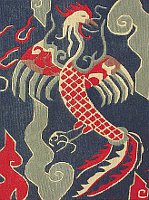 The phoenix is a mysterious, self-regenerating ('like a Phoenix out of ashes') bird that can be traced back to the mythologies of many ancient cultures - Egyptians, Romans, Greeks, India, Chinese, Indonesia, Persia, Central America and many more. It is astonishing how the same type of creature can show up in old tales of so many different world cultures.
The phoenix is a mysterious, self-regenerating ('like a Phoenix out of ashes') bird that can be traced back to the mythologies of many ancient cultures - Egyptians, Romans, Greeks, India, Chinese, Indonesia, Persia, Central America and many more. It is astonishing how the same type of creature can show up in old tales of so many different world cultures.
The Tibetans make no exception and in their rich culture you find the symbol of the phoenix bird on Tibetan arts and crafts, frequently on rugs. This article tries to explain the phoenix symbol used with Tibetan carpets.
The Tibetan Phoenix - an Auspicious Symbol
I once had a client who wanted to buy a Tibetan rug and was a bit superstitious. For each rug design he asked me about the exact meaning of the symbols used in the design. Finally I realized that his only concern was not to buy a carpet with a bad omen.
I could calm this man down with a simple point. Tibetans are no idiots. When they make a rug or another piece of handicraft or art, they want to sell it. Therefore all symbols on Tibetan rugs are auspicious signs.
And you guess it. Also the phoenix makes no exception and is an auspicious symbol.
The Meaning of the Tibetan Phoenix
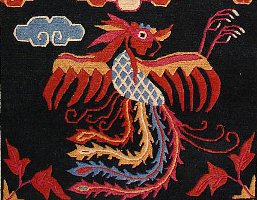 The symbol of the phoenix bird was most presumably taken from the Chinese culture, and the meaning is rather identical. The phoenix image stands for eternal life and benevolence. The appearance of this majestic bird on earth signals peace and prosperity for mankind.
The symbol of the phoenix bird was most presumably taken from the Chinese culture, and the meaning is rather identical. The phoenix image stands for eternal life and benevolence. The appearance of this majestic bird on earth signals peace and prosperity for mankind.
Phoenix in Other World Cultures
Due to its ability to die in its own flames and then resurrect out of the ashes, the phoenix stands for immortality in all cultures with a mythological story about this bird creature. In early civilizations of mankind the sun played a major role and was the center of early religious cults. Maybe this mythological bird is an analogy to the daily disappearance and resurrection of the sun?
The very name of the phoenix may have come from the old Phoenicians, a population of merchants and sailors from the Mediterranean sea. But that is subject to speculations.
The earliest written documents mentioning the phoenix are by Roman historians - Ovid, Plinius the Elder and Tacitus.
In Egypt the phoenix is called Benu.
What Looks a Tibetan Phoenix Like?
But let us go back to our variation, the Tibetan phoenix. In the standard book Tibetan Rugs by Hallvard Kare Kuloy the phoenix is described as an odd, composite creature.
- The front of a wild swan.
- The behind of the unicorn.
- The throat of the swallow.
- The bill of a fowl.
- The neck of a snake.
- The tail of a fish.
- The forehead of a crane.
- The crown of a mandarin drake.
- The strips of a dragon.
- The vaulted back of a tortoise.
It is not mentioned in Hallvard's book where this definition comes from. But it is rather identical with the description of the Chinese Feng Huang, another species of this mythological beast. In China, by the way, the use of a phoenix as a symbol was limited to important persons. The Chinese meaning of phoenix is also honesty and virtue.
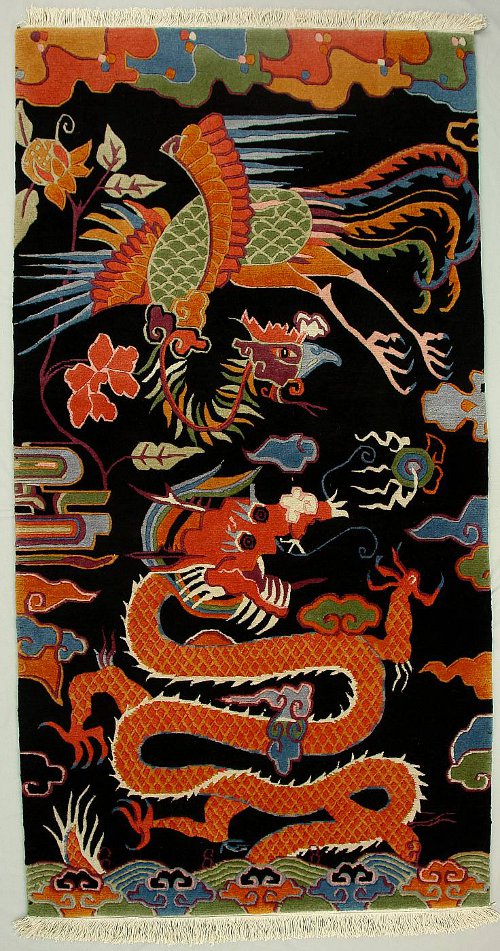
Why Does he Hold a Twig in his Beak?
Sometimes you can see the phoenix without this twig. But often he carries a twig in his beak. I am not sure about the meaning of the twig in the bird's beak. Is it a reference to the old tales about the phoenix who collects a pile of wooden twigs when his time to regenerate has come. When he has enough twigs, the bird climbs on the wooden pile and burns himself to ashes. A few days later a small worm comes out of the ashes. And out of the worm, a new phoenix arises. This is supposed to happen every 500 or thousand years.
Strange! If any of the visitors on this page can shed a bit of light on the symbol of the twig in the bird's beak, please add a comment below.
Phoenix and Dragon - a Perfect Match
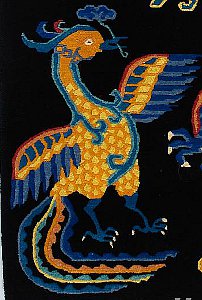 Do you know the characteristics of the Tibetan dragon? Well, that sounds similar. Benign, benevolent, helpful and pretty skillful in managing the rain. In short, sounds like a nice guy. And looks like these two, the Tibetan phoenix and the Tibetan dragon make a good match. And they do.
Do you know the characteristics of the Tibetan dragon? Well, that sounds similar. Benign, benevolent, helpful and pretty skillful in managing the rain. In short, sounds like a nice guy. And looks like these two, the Tibetan phoenix and the Tibetan dragon make a good match. And they do.
However if they come in two, they get an additional, new meaning. They represent the duality like 'Emperor and Empress', 'Male and Female', 'King and Queen'. On Tibetan rugs one can see these funny guys pretty often as a pair.
Gallery of Tibetan Phoenix Rugs
There are a few basic patterns of a phoenix bird on a Tibetan rug. The typical design elements are:
- One phoenix. This design is rather rare.
- Two phoenix as a pair.
- One phoenix and one dragon.
- Phoenix medallion.
More Tibetan Phoenix
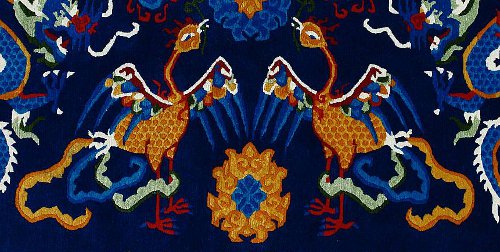
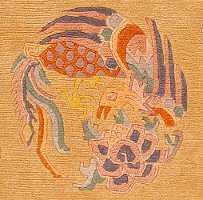
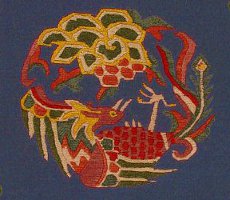
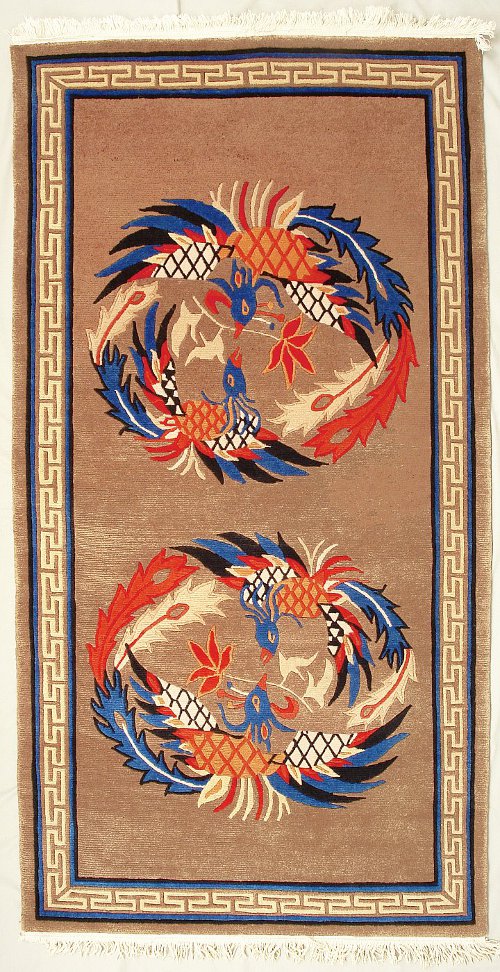
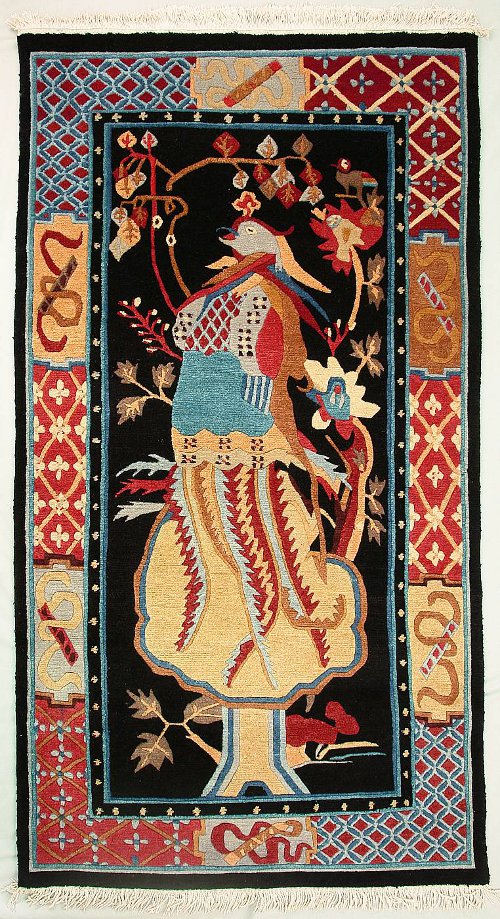
Dieter Wanczura, October 2010.
Literature Reference
Tibetan Rugs, by Hallvard Kare Kuloy. White Orchid Press, Bangkok. First printing in 1982. ISBN 974-82999-94-5.







